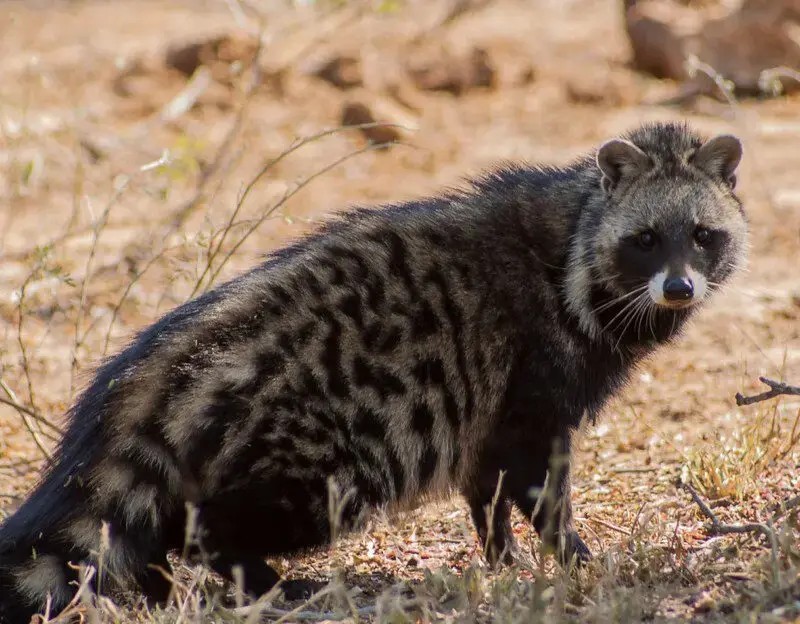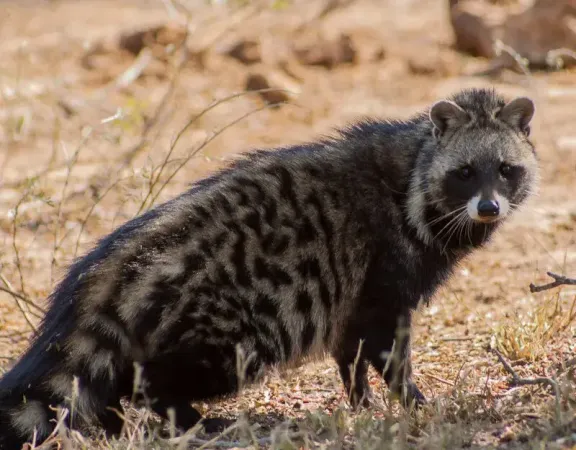

The African civet (Civettictis civetta) is a small, catlike mammal. It is native to southern and central Africa, preferring habitats that include savannas and forests. This specialist game hunting trophy is an accomplished swimmer and chooses to inhabit areas close to the water while rarely being found in arid regions.
Civet hunting in Africa is available in numerous African countries, including South Africa, Cameroon, Namibia, Tanzania, Namibia, Zimbabwe, Zambia, and the CAR. Its status with the IUCN is “least concern.”
The nocturnal civet is a solitary, mysterious animal, preferring to rest and hide during the day before venturing out at night to hunt. It is adept at climbing and spends lots of time in trees, so look up during your African hunting adventure!
They are most active for about an hour after dark as they hunt. Civets enjoy an omnivorous diet that includes carrion, birds, eggs, crabs, rodents, reptiles, fruits, and insects.
Females breed from roughly one year old and can produce 1-2 litters per year. Young are born after a gestation period of 57-63 days. Between 1-4 are young born, and they are dependent on their mother for the first few weeks of their lives. The young civets eat solids from about four weeks and start hunting at around eight weeks old.
The civet is prey to numerous animals larger than itself, including hyenas, wild dogs, snakes, and crocodiles. It is often on the menu for many large cats, including lions and leopards.
Name:
Civettictis Civetta
Male Weight:
22-33 pounds
Male Shoulder Height:
16 inches
Range:
South and Central Africa
Gestation Period:
57-63 days
Life span:
15-20 years
Solitary Habits Make Civet a Challenge to Target on a Game Hunting Safari.
When on a game hunting safari targeting civets, look for a slender catlike animal with a bushy, dark tail, a sharp muzzle, and rounded ears. Its shading ranges from brownish to gray, with a black spot or stripe-like pattern on its body. It sports black legs, and most of its tail is also black. Weighing about 22-33 pounds, the civet stands approximately 16 inches at the shoulder.
Civet hunting in Africa is usually part of a specialist game hunting safari. Enjoy civet hunting using the spot and stalk method or a spotlight for a nocturnal hunting adventure! Nothing is quite as exciting as a night-hunting adventure under African skies! Spotlights target the animal, allowing for an exhilarating hunting safari as hunters search for this elusive animal.
Civet hunting in Africa is a rewarding hunting adventure. Your prey is known as being secretive and camouflages itself well within trees, thickets, or long grass, so should you spot them during the day, it's already a major accomplishment! They are extremely fast-moving, making the challenge of successfully hunting this elusive mammal at night even more rewarding.
Any regular plains game hunting rifle is sufficient to get your civet into the salt; 7mm Rem Mag, 30-06 Springfield, .308 Win Mag, and 300 Win Mag will all work well. Smaller fast shooting calibers such as a .243 or 223 will also work nicely, and big bore rifles such as a .375 H&H, .416 Rigby, or .458 Win mag will get the job done. The hunter must focus on the ammunition used on the game hunting safari. When on a general plains game animal, a hunter would ideally use expanding or soft bullets, on a small mammal such as the African civet, one should use a monolithic non-expanding bullet. This will eliminate a large exit wound, with a small entry and exit hole and small wound channel, preserving your trophy and making it easy for your taxidermist to work with your game hunting trophy.
Search from our range of Hunts across various popular destinations in Africa.
Find A Hunt